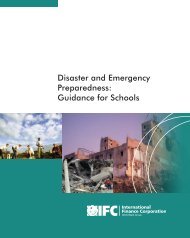early childhood development - INEE
early childhood development - INEE
early childhood development - INEE
Create successful ePaper yourself
Turn your PDF publications into a flip-book with our unique Google optimized e-Paper software.
Incorporating local culture and customs can enhance the effectiveness and acceptance of ECD programs. Forexample, ECD activities through training and community awareness can possibly be built into indigenouseducation structures such as religious schools (madrasas), or traditional songs and story telling by elders. Localchild-rearing customs should always be investigated as they vary worldwide and will affect the program design.For example, in some parts of the world, older siblings take care of their young siblings rather than the parents,grandparents or relatives. With this in mind, ECD programs should not target only adults but also older children.• Facilitate the <strong>development</strong> of sustainable ECD programs• Target pre-school children in most vulnerable portions of community• Early child education programs should be integrated with other humanitarian services and provision ofmaterials.Ideally, ECD activities should be close to Maternity Child Health (MCH) clinics to ensure that children’s healthconcerns and especially immunization are addressed. ECD activities for children and training for parents shouldbe included in therapeutic feeding programs.ChecklistAssessment of <strong>early</strong> <strong>childhood</strong> activities• Did <strong>early</strong> <strong>childhood</strong> education exist before the crisis? Was food provided? Was the service half-day orfull day?• In what areas did <strong>early</strong> <strong>childhood</strong> education exist?• Did the government support the <strong>early</strong> <strong>childhood</strong> program?• Did parents pay for their children to attend? Was the service only for people who belonged to a certaincompany or the government?• Were the teachers/facilitators/volunteers trained? Where were they trained? Could young people orelderly be involved in providing the activities for children?• Is the ECD center located close to a facility offering services for under-five children such as aMaternity Child Health Clinic?Existing activities in ECD centers:• Are ECD activities presently occurring within the community? Are all children able to access theseactivities? Minorities? Children with disabilities? Which ages?• Is the space sufficient for both indoor and outdoor play?• If space is insufficient can morning and afternoon activities be held to accommodate all of thechildren?• Are the teachers/facilitators/volunteers trained? Where were they trained? Could young people or theelderly be involved in providing activities for children?• Is there a system of referral in place for traumatized children or children with special protection needs?To whom are they referred? What cases have been referred?• What is the relationship between the existing activities and the government? Are the ECD activitiesregistered with the government?Parent Training:• As survivors of a crisis, do parents and caregivers regularly have the opportunity debrief each other ontheir experiences and the challenges of raising children in a difficult environment?• Have parents received written materials or training on the importance of <strong>early</strong> <strong>childhood</strong> <strong>development</strong>and activities that they could do at home? Have child rights been included in the parent/caregivertraining?2
















